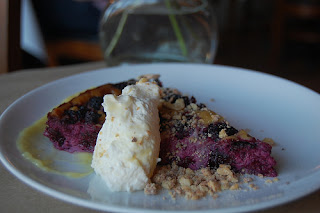from
Behind the French Menu
by
Bryan G. Newman
behindthefrenchmenu@gmail.com

Omble
Chevalier - Alpine Char
Photograph courtesy of Le Pecheur Professionnel
Alpine Char, Arctic Char
Omble Chevalier, Omble Arctique - Alpine Char, Char, Arctic Char. Charr has a taste somewhere between trout and salmon, to which they are related. Char has a firm, but slightly flaky flesh, with a white to pink color; the color depends on the food that the fish has been eating.
When Char is caught in one of France’s many clear water lakes, then restaurant menus will often identify the area or name the lake where this fish was caught. When Char is caught in a river or an estuary, the menu may note Omble Chevalier Sauvage, wild char since char are also raised in fish farms. The lakes are stocked so that professional and amateur fishers can enjoy them. Large fish can weigh up to five kilos (11 lbs) and will be served as filets, while small fish will be served whole. When traveling around France, you will find lakeside restaurants, especially around Lac Léman (Lac de Genève), Lac du Bourget, and Lac Annecy will often have fresh Char on their menus.
Artic Char
with Oysters,www.flickr.com/photos/scaredykat/6849471786/ Char, Alpine Char on French Menus:
Omble Chevalier Sauvage Cuisiné au Beurre Mousseux aux Fines Herbes – A whole, wild, freshwater char, cooked in
foaming butter and flavored with the herbs from France’s favorite herb group called Les Fines Herbes.
Omble Chevalier sur un Risotto à la Bisque d'Écrevisses et Gambas
Alpine char served on a risotto of shrimp and a freshwater crayfish bisque.
Photograph courtesy of Trip Advisor
La Meunière
d'Omble Chevalier et Ecrevisses de Camargue, Beurre au Thym - A whole Alpine Char fried
in a meunier butter sauce flavored with thyme; served
with freshwater crayfish from the Camargue National Park on France's Mediterranean coast.
The Meunière sauce in the menu listing above is a simple but tasty butter sauce made by adding lemon juice and parsley to melted clarified butter. That sauce is often translated as a sauce or as a dish prepared in the manner of a miller's wife.
One of my correspondents on French cuisine, Michel Mass, points out that the miller’s wife story is another urban legend probably explained by the fact that Meuniere recipes often imply that the fish should be rolled in flour before cooking. However, the word meunière was initially
related to various species of freshwater fish that in the past went by the
collective name of meuniers; then they included the plentiful Common Bullhead,
Chabot in French, and Chub, Chevaine in French. The mill ponds built close to water mills were a haven for these fish and, consequently, anglers.
Unfortunately, today, we will rarely see Bullhead or Chubb on the menu, but you can order saltwater fish, including Dover sole, freshwater trout and char, alongside many other fish
prepared à la meunière.
Filet d’Omble
Chevalier des Cévennes Rôti au Beurre Beurre Noisette aux Noisette aux Girolles Poêlées – A filet of Alpine Char caught in one of the many
beautiful lakes in the Cévennes National Park. The fish will have been roasted
whole with a sauce beurre noisette and wild chanterelle girolle mushrooms. The fish will be fileted just before serving. (The
Cévennes National Park covers parts
of the departments of Lozère, Gard, Ardèche and Aveyron). The Lac de Villefort, in the park, is a
favorite place for amateur anglers and water sports.
Tartare d’Omble Chevalier,
Avocat, Combawa et Coriandre - A Tatar of Alpine char
prepared with avovado, kafir limes and coriander.
Omble Chevalier Fumé Maison, Cœur d'Artichaut, Avocat, Sauce
Yogourt à l'Aneth – Alpine char smoked by the restaurant served with artichoke heart, avocado, and a sauce of dill and yoghurt.

Alpine Char
with Butternut Squash Ravioli in a Saffron Broth
Photograph courtesy of Chris Chen 陳依勤
www.flickr.com/photos/cchen/61333685/
When the
music stops.
I enjoyed a memorable meal with a magnificent, whole, freshwater char as the star in a restaurant on the banks of Lac Léman, (Lac de Genève), France. The setting, the restaurant, and the fish were magnificent. The fish was incredibly fresh as if it had been landed five minutes before. It was served lightly fried in a Sauce Meunier …heaven.
I went back to the same restaurant a few years later; the taste was still so
fresh in my mind that I could hardly wait for the fish to arrive. Then disaster
struck. I was served a recently unfrozen trout filet! The disappointment was
unimaginable, never will I return; bell, book, and candle for that restaurant! However, since then, I have found other restaurants on the banks of Lac Leman that sell the genuine article. Caveat Emptor: ask to see the
fish before it is cooked.

The Freshwater Char is above and the trout is
below
Photograph courtesy of the Biodiversity
Heritage Library.
Unsere SuÌ,6Ã8wasserfische
Leipzig :Quelle & Meyer,1913.
biodiversitylibrary.org/page/10028049
www.flickr.com/photos/biodivlibrary/6103144706/
Freshwater
char is not necessarily a freshwater fish.
Most French citizens assume that char is only a local freshwater fish; that is an error. Char, given a chance, would spend much of their lives at sea, primarily in Arctic waters. However, over thousands of years, char have been released into European lakes, and there they spend their whole lives. Others are raised in freshwater fish farms.
Char in the languages of France’s neighbors:
(Dutch - beekridde, riddervis )(German - saibling, seesaibling), (Italian – salmerino, salmerino alpino), (Spanish –salvelino), (Latin - salvelinus alpinus).
--------------------------------













